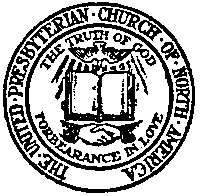United Presbyterian Church of North America facts for kids
Quick facts for kids United Presbyterian Church of North America |
|
|---|---|
 |
|
| Classification | Protestant |
| Orientation | Calvinist |
| Polity | Presbyterian |
| Origin | May 26, 1858 Pittsburgh |
| Merger of | Northern branch of the Associate Reformed Presbyterian Church (Covenanter and Seceder) and the Associate Presbyterian Church (Seceders) |
| Merged into | The United Presbyterian Church in the United States of America (1958) |
| Congregations | 839 in 1957 |
| Members | 257,513 in 1957 |
| Ministers | 996 in 1957 |
The United Presbyterian Church of North America (UPCNA) was a Christian church group in America. It was a type of Presbyterian church. This church existed for 100 years. It started on May 26, 1858. This happened when two groups joined together in Pittsburgh. These groups were the northern part of the Associate Reformed Presbyterian Church and the Associate Presbyterian Church.
Later, on May 28, 1958, the UPCNA joined with another large church. This was the Presbyterian Church in the United States of America (PCUSA). They formed a new church called the United Presbyterian Church in the United States of America (UPCUSA).
At first, most members of the UPCNA were from Scotland. Over time, it became more diverse. But everyone spoke English. The church was strongest in Western Pennsylvania and eastern Ohio. These areas had many Scottish and Scotch-Irish settlers. Many members lived in the countryside. This made the church keep its traditional ways.
Contents
The Seceders: A New Start
The people who started the Associate Presbyterian Church were called "Seceders." They came directly from Scotland. They had left the main church in Scotland due to disagreements. Even after some peace was made in Scotland, American Seceders stayed separate. In 1858, most of them joined with the Associate Reformed Presbyterian Church. This created the United Presbyterian Church of North America.
The Associate Reformed Church's Journey
The Associate Reformed Church began in 1782. It was formed by two groups: Associate and Reformed Presbyterians. This church became very strong in the Midwest. It was called the Associate Reformed Synod of the West. In 1820, this group separated from its parent church. This was because the eastern churches were changing.
The Associate Reformed Synod of the West kept its strong traditions. Its members were mostly Scotch-Irish immigrants. They followed the Westminster Confession of Faith. They only sang Psalms during worship. They believed in keeping Sunday special. They were also strongly against slavery and the Catholic Church. By the 1850s, the church started to change. It became more open to working with other churches. It also showed more interest in spreading its faith in the West and in cities.
What They Believed and Practiced
The UPCNA believed in a traditional form of Calvinism. They also followed special practices from the Covenanters and Seceders. These included public covenanting (making promises to God together). They also used only Psalms for singing in church. (Another similar church, the Reformed Presbyterian Church of North America, still does this.)
In the 1900s, the church changed some of its rules. For example, in 1925, they released a new statement. This statement said that practices like only singing psalms were no longer required.
Joining Together: The Merger
Around the 1950s, the UPCNA looked to join with other Reformed churches. In 1958, its 100th year, it agreed to merge. It joined with the much larger PCUSA. This formed the UPCUSA.
Most churches from the UPCNA joined the Presbyterian Church (USA) in 1983. This church followed the UPCUSA. However, some local churches were more traditional. They left in the 1970s. They joined other groups like the Presbyterian Church in America (started 1973) and the Evangelical Presbyterian Church (started 1981).
Global Missions
The UPCNA was very active in sending missionaries to other countries.
Work in Egypt
American missionaries first arrived in Egypt in 1854. They worked to convert Copts, who are Egyptian Christians. Sometimes, they also reached out to Muslims. By 1875, they had 600 converts. By 1895, they had 4,600 members. Local leaders were not always friendly. But by 1917, the "American Mission" was the biggest Protestant group in Egypt.
The American Mission trained local church leaders. They also built schools. By 1894, they had formed their own church structure in Egypt. By 1926, this became the "Evangelical Church in Egypt." It was still part of the UPCNA but governed itself. It even had its own seminary (a school for training ministers).
Later, in the 1930s, there were challenges. Egyptian ministers and American missionaries had disagreements. They argued about converting Muslims and adopting Western ideas. The church in Egypt became independent. In 1957, it was fully controlled by Egyptians. It became the Coptic Evangelical Church.
The American Mission also started the American University in Cairo in 1919. This university became a center for American ideas and modern ways in the Arab world. However, the university is no longer connected to the UPCNA.
Work in Colonial India
The UPCNA also started the Sialkot Mission in 1854. This mission was in colonial India. Its goal was to train leaders for the Synod of the Punjab. This area was later divided into India and Pakistan in 1947.
United Presbyterian churches were built in many cities in the Punjab. These included Rawalpindi (1856), Gujranwala (1863), and Lahore (1913). Christian missionaries also built hospitals, schools, and colleges.
These missions trained many local leaders. They included village elders, pastors, and even a bishop. They also trained craftsmen, teachers, doctors, and nurses. After India was divided, the Pakistani government took over the mission schools. Training new leaders became more difficult.
See also
- List of Moderators of the General Assembly of the United Presbyterian Church of North America

